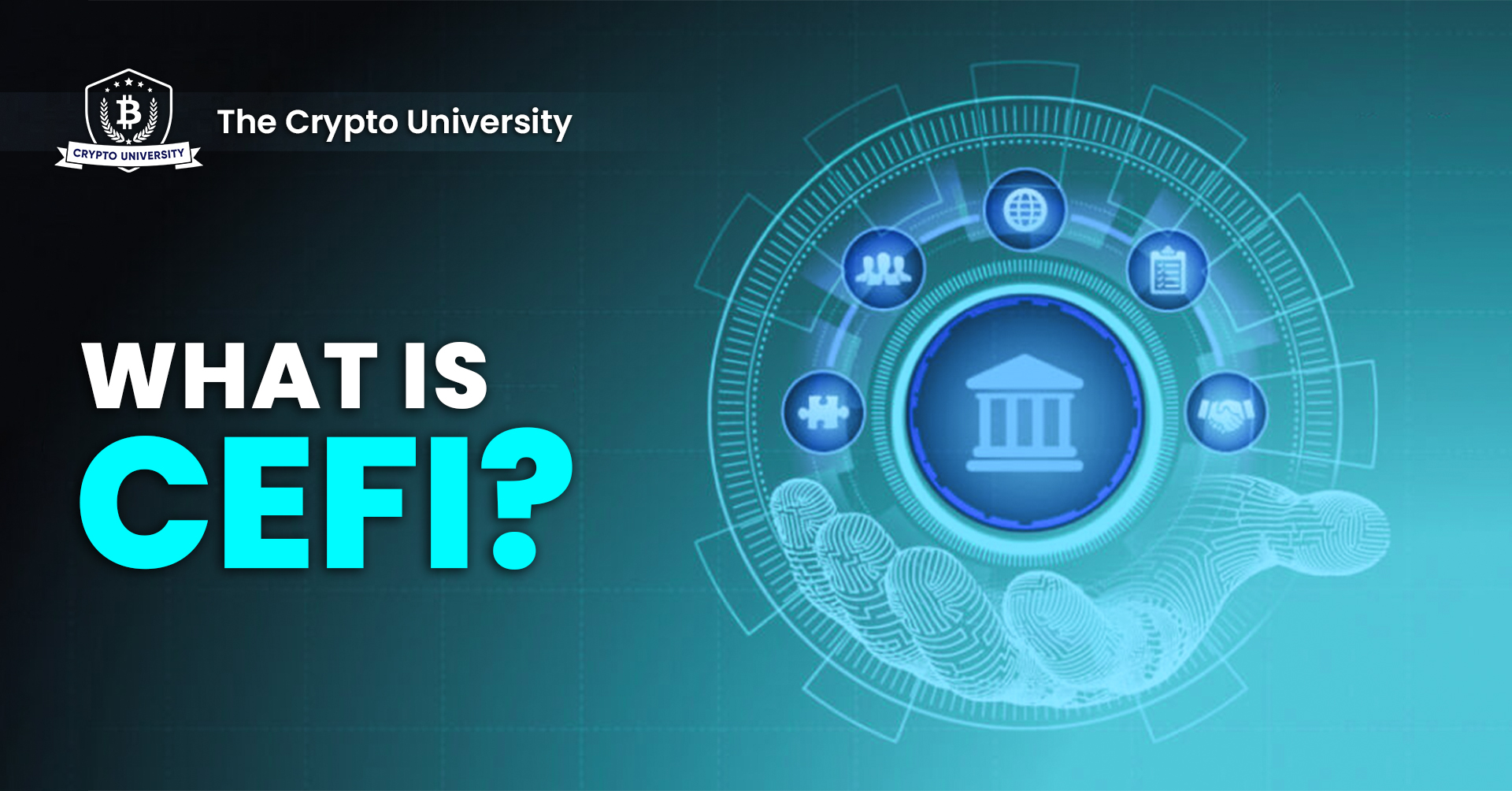Are you interested in learning more about CeFi and how it works? Here’s a detailed guide for you. In this blog post, we’ll discuss what CeFi is, how it works, and some of the benefits and risks associated with it. We’ll also introduce you to some of the most popular CeFi platforms. By the end of this post, you will have a better understanding of CeFi and whether it’s a better option to explore than DeFi.
What is CeFI?
CeFi is a type of financial system that uses cryptocurrency and blockchain technology to provide traditional financial services, such as lending, borrowing, and trading. But it does all these in a centralized manner. This means that there is a single entity that controls the platform and all user funds. Its model contrasts with decentralized finance (DeFi), which is completely decentralized and does not have a central point of control.
When you use a CeFi platform, such as a centralized cryptocurrency exchange, you’re placing your trust in these intermediaries to safeguard your assets and facilitate your transactions. They act as gatekeepers, regulating access to financial services and overseeing the movement of funds.
These platforms are often preferred by beginners or those seeking a more familiar and user-friendly experience. They provide a high level of liquidity, making it easy to buy, sell, and trade various cryptocurrencies.
Additionally, they usually offer customer support, advanced trading features, and integration with fiat currencies, making it simpler to enter and exit the crypto market.
Further, CeFi platforms typically require users to complete a Know Your Customer (KYC) process, which involves providing personal identification documents. This requirement is imposed to comply with financial regulations and prevent money laundering and other illicit activities.
What are the features of CeFi?
CeFi has several key features that set it apart from other financial systems. Here’s a breakdown of the main features you need to know:
Trusted Intermediaries: CeFi relies on trusted intermediaries to facilitate transactions and manage user accounts. These intermediaries act as custodians of funds and are responsible for executing transactions on behalf of users.
Centralized control: These platforms are controlled by a central authority, such as a company or a group of developers. This means that they have the power to approve or deny transactions, freeze accounts, and change the terms of service.
Regulation: CeFi platforms are subject to government regulation, which can vary from country to country. This can make it difficult to use CeFi platforms in some jurisdictions.
Security: CeFi platforms use a variety of security measures to protect user funds, such as cold storage, encryption, and multi-factor authentication. However, there is always the risk of hacks and theft.
Fees: They typically charge fees for their services, such as trading fees and withdrawal fees. These fees can vary from platform to platform.
User-Friendly Interface: These platforms offer intuitive and user-friendly interfaces, making it easy for individuals to interact with financial services. Features such as account management, trading, and accessing various financial products are easily accessible to users.
Liquidity: CeFi platforms often provide high liquidity, allowing users to quickly buy or sell assets without experiencing significant price slippage. Centralized exchanges, for example, aggregate orders from multiple users, enabling efficient trading.
Benefits of CeFi
There are several benefits to using CeFi platforms. Here are seven of them:
Access to fiat currencies: CeFi platforms allow you to buy and sell cryptocurrencies with fiat currencies, such as US dollars and euros. This can be helpful if you are not yet familiar with the cryptocurrency market and want to start by investing with fiat currencies.
Margin trading: These platforms make it possible to trade cryptocurrencies with leverage, which means you can borrow funds from the platform to increase your trading position. This can be a risky strategy, but it can also allow you to make more profits if you are right about the market direction.
Staking: CeFi platforms allow you to stake your cryptocurrencies to earn rewards. Staking is a process of locking up your cryptocurrencies to support the security of a blockchain network. In return, you are rewarded with new cryptocurrencies.
High liquidity: These platforms typically experience high liquidity in trading, which means that you can easily buy and sell cryptocurrency without having to worry about slippage.
Customer support: CeFi platforms typically offer customer support, which can be helpful if you have any questions or problems.
Easy to use: CeFi platforms are typically very user-friendly, making it easy for beginners to get started with cryptocurrency.
Various CeFi Use Cases
Here are some examples of CeFi use cases:
Centralized Cryptocurrency exchanges: These platforms allow you to buy, sell, and trade cryptocurrencies. Some of the most popular cryptocurrency exchanges include Binance, Coinbase, Huobi, Kucoin, and ByBit.
Lending platforms: These platforms allow you to lend your cryptocurrencies to others and earn interest. Some of the most popular lending platforms include Nexo, Coinloan, and YouHodler
Borrowing platforms: These platforms allow you to borrow cryptocurrencies against your fiat currency or other cryptocurrencies. Some of the most popular borrowing platforms include MoneyToken, CoinRabbit, and Unchained Capital.
Fiat Onramps and Offramps: CeFi platforms act as gateways between the traditional financial system and the cryptocurrency ecosystem. They offer fiat onramps, allowing users to convert traditional currencies into cryptocurrencies, and fiat offramps, enabling users to convert cryptocurrencies back into traditional currencies. Examples of such platforms are Binance, Huobi, and Kucoin.
Token Launchpads: Centralized token launchpads allow projects to conduct initial coin offerings (ICOs) or initial exchange offerings (IEOs) to raise funds and distribute their tokens to investors. This feature provides a centralized and regulated environment for both project owners and investors, facilitating fundraising and token distribution processes. Examples of CeFi tolen launchpads include Binance Launchpad, Gate.io Launchpad, and Kucoin Spotlight.
Challenges and Risks of CeFi Platforms
Here are some of the challenges and risks that are common in most CeFi platforms:
Centralized control: CeFi platforms are controlled by a single entity, which means that they have the power to freeze your account, change the terms of service, or even shut down the platform altogether. This can be a major risk if you’re not comfortable with putting your financial future in the hands of a third party.
Hacking risk: They are often targeted by hackers because they hold large amounts of cryptocurrency. If a CeFi platform is hacked, you could lose your funds.
High fees: CeFi platforms typically charge higher fees than decentralized finance (DeFi) platforms. This is because they need to cover the costs of running and maintaining their businesses.
Custody risk: When you deposit your cryptocurrency on a CeFi platform, you’re giving up control of your private keys. This means that the platform could potentially lose your funds or access them without your permission.
Lack of transparency: CeFi platforms are often not as transparent as decentralized finance (DeFi) platforms. This can make it difficult to know how your funds are being used and what risks you are taking.
Solvency risk: CeFi platforms are centralized entities, which means they are susceptible to the same risks as traditional banks, such as insolvency. If a CeFi platform goes bankrupt, you may lose your funds.
How is Cefi different from DeFi?
CeFi relies on the trustworthiness and security measures implemented by centralized institutions. Users trust these institutions to safeguard their assets and personal information. DeFi, on the other hand, is built on the principles of transparency and trustlessness. Funds in DeFi protocols are typically held in users’ wallets.
Apart from that, CeFi often requires users to comply with Know Your Customer (KYC) and Anti-Money Laundering (AML) regulations. This can create barriers for individuals who do not have access to traditional identification documents or banking services. On the other hand, the decentralized nature of DeFi applications provides greater accessibility and financial inclusion. Individuals can participate in financial activities without needing to go through long verification processes.
Also, DeFi protocols often have decentralized governance models, where decision-making power is distributed among token holders. CeFi platforms, on the other hand, have centralized governance structures where decisions are made by the platform’s management or stakeholders.
Lastly, CeFi platforms have an established infrastructure that enables them to scale their services efficiently. DeFi, being relatively newer, is still undergoing development and innovation to improve scalability and address the challenges of processing a high volume of transactions on the blockchain.
Conclusion
In this post, we explained the topic: “What is CeFi” in detail, and we learned about some of the benefits it offers, like convenience, security, and a wide range of services to help you manage your finances effectively. You’ve also discovered the various Use cases of CeFi. While it may not have the decentralized allure of DeFi, CeFi remains a reliable and trusted option for many individuals and institutions who are looking for a more user-friendly way to get involved in the crypto space. However, it’s important to do your research and understand the risks involved before you engage with any CrFi platform.
If you want to build a consistently profitable crypto portfolio, join the Crypto University membership now.





